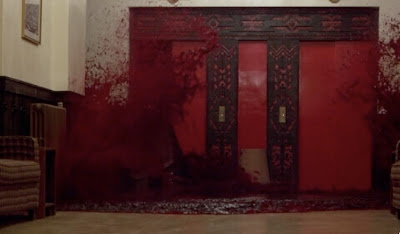It's also a testament to these classic movies that they are so rich in imagery that we have both been able to pick out such powerful moments from each one. These are moments that have perfectly distilled these particular films for us, eloquently stating the central theme or idea that the movie is trying to convey.
We hope you enjoy the second and final batch of screen-caps...
THE RETURN OF THE LIVING DEAD
B-Sol:One of the most fascinating aspects of Return of the Living Dead is the frank way in which the film confronts death--pretty ironic considering it is a horror comedy. And this confrontation with the other side is never more fully expressed than it is in this one unnerving moment when Ernie interviews one of the undead to learn what makes them tick. Creepy in the extreme...
 Andre:
Andre:This has always been my favorite screen grab of Return of the Living Dead. For a similar reason to my American Werewolf selection, this shot also shows that ROTLD had some meat on its bones. My favorite horror comedies are the ones that retain the scares, and Return of the Living Dead had that. This in particular is always such a chilling moment for me, almost different in tone and unexpectedly causes you to catch your breath.
THE SHINING
 B-Sol:
B-Sol:The story of one man's dizzying descent into madness, this film brings us face-to-face with the insanity that lies within us all, waiting to be released. We watch as Jack Torrance become more and more unhinged, culminating in an orgy of deranged violence. This moment, right after Jack has dispatched poor Scatman Crothers, says it all.
 Andre:
Andre:This is a moment that defines the sensory overload that happens in The Shining. The fear and the horror, the anxiety and the terrifying images, seem to just gush out of the screen when you are watching it. It's surprising, beautiful and timeless--all things that I happen to love about The Shining.
SUSPIRIA
 B-Sol:
B-Sol:It has been said that Dario Argento is the master of making horror look beautiful, and as a direct extension of this, it's obvious that for him, murder is a sexual act. This is at the heart of his work (pardon the awful pun), and here in Suspiria we witness the ultimate distillation of this notion, as the killer's knife penetrates flesh.
 Andre:
Andre:This double death scene early on in the film is the defining moment of not only Suspiria, but Dario Argento, as well. It perfectly exemplifies the idea of film as an art form. Quite literally, as this shot in particular looks like a painting. Every time I look at it, it takes my breath away and continuously reminds me why I love that little thing called a terrible beauty.
NOSFERATU
 B-Sol:
B-Sol:The figure of Count Orlock is what makes Nosferatu such a terrifying film, even today. His menacing form and threatening demeanor truly make this movie a so-called "Symphony of Fear". Here, the Count famously ascends the stairs to claim his final victim. Perhaps the most classic vampire entrance of all time.
 Andre:
Andre:For me this is the quintessential portrait of Count Orlok. He will continue to scare the crap out of me until my dying day. This moment where he stands on the threshold of Thomas' room, peering in and standing so rigid and so grotesque looking will always send shivers down my spine.
A NIGHTMARE ON ELM STREET
 B-Sol:
B-Sol:The invasion of Freddy into the dreams of his victims represents a powerful violation, and nowhere is this more vividly expressed than in Nancy's infamous bathtub nightmare, in which the slasher's razor glove appears from between the legs of Ms. Thompson. Paging Dr. Freud...
 Andre:
Andre:This shot proves the almost suffocating effect that Freddy has on his victims. It's such a marvelous shot that it almost feels out of place in a way. It's intrusive, and it's even unexpected. Freddy is supposed to be with Tina isn't he? Two places at once?!
GOJIRA
 B-Sol:
B-Sol:What sets the original Godzilla apart from the endless stream of sequels is the way in which the film takes the damage wrought by the monster so seriously, measuring it in a human toll, and not just wanton property damage. This is a movie about people and how their lives are affected by a monster, not about the monster itself. This shot, in which a mother, confronted with imminent death, comforts her children by letting them know they will soon be with their father (presumably killed a few years earlier in World War II). Pretty heavy stuff for a man-in-suit flick.
 Andre:
Andre:This scene always catches me off guard. Originally, I had decided on the iconic shot of the fire breathing Gojira, but this moment kept calling out to me. It shows the heavy sadness that exudes from the overlaying themes in Gojira. The idea that although the destruction and effects of nuclear war were devastating, there still remained at least a shred of hope and beauty. I think highlighting this aspect is important to do amongst the loudness and anger of Gojira.
